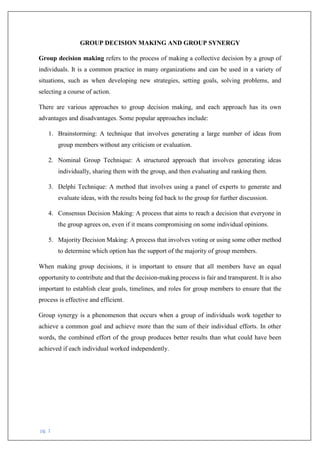GROUP DECISION MAKING AND GROUP SYNERGY.docx
- 1. pg. 1 GROUP DECISION MAKING AND GROUP SYNERGY Group decision making refers to the process of making a collective decision by a group of individuals. It is a common practice in many organizations and can be used in a variety of situations, such as when developing new strategies, setting goals, solving problems, and selecting a course of action. There are various approaches to group decision making, and each approach has its own advantages and disadvantages. Some popular approaches include: 1. Brainstorming: A technique that involves generating a large number of ideas from group members without any criticism or evaluation. 2. Nominal Group Technique: A structured approach that involves generating ideas individually, sharing them with the group, and then evaluating and ranking them. 3. Delphi Technique: A method that involves using a panel of experts to generate and evaluate ideas, with the results being fed back to the group for further discussion. 4. Consensus Decision Making: A process that aims to reach a decision that everyone in the group agrees on, even if it means compromising on some individual opinions. 5. Majority Decision Making: A process that involves voting or using some other method to determine which option has the support of the majority of group members. When making group decisions, it is important to ensure that all members have an equal opportunity to contribute and that the decision-making process is fair and transparent. It is also important to establish clear goals, timelines, and roles for group members to ensure that the process is effective and efficient. Group synergy is a phenomenon that occurs when a group of individuals work together to achieve a common goal and achieve more than the sum of their individual efforts. In other words, the combined effort of the group produces better results than what could have been achieved if each individual worked independently.
- 2. pg. 2 Group synergy can arise from a variety of factors, such as: 1. Diversity: When individuals from different backgrounds, experiences, and perspectives come together, they can bring unique ideas and approaches to the table, leading to a more comprehensive and innovative solution. 2. Collaboration: When group members work together and share their knowledge and skills, they can leverage each other's strengths and compensate for each other's weaknesses, leading to a more effective and efficient outcome. 3. Encouragement: When group members provide each other with support and encouragement, they can motivate each other to work harder and achieve more than they would on their own. 4. Positive Interdependence: When group members feel that their success is tied to the success of the group as a whole, they are more likely to work together and collaborate to achieve their goals. Creating group synergy can be challenging, and it requires effective communication, cooperation, and a sense of shared purpose. To achieve group synergy, it is important to set clear goals, establish trust and mutual respect among group members, and provide opportunities for open and honest communication. Additionally, it is essential to create an environment where everyone feels valued and respected, and where individuals are encouraged to share their ideas and perspectives.


